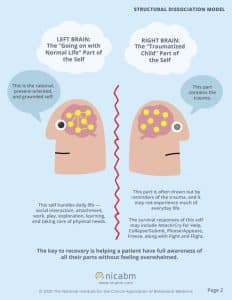Recently, a sporting scandal broke out at a prestigious university in the US, Northwestern University. To this point, more stories are coming out to the public that suggests the scandal is bigger than what reporters originally thought it would be. The psychology behind hazing is what I plan to focus on in this short blog. During one of the biggest sports scandals in college history, I stand in the trenches for many athletes who need advocacy. As a former player at Northwestern University, I watch this scandal unfold and I am in utter shock. The shock does not come from what I am witnessing at this moment. The shock comes from what people in power are willing to do to remain in power. One major feature of this scandal is the long-term effects hazing will have on all the athletes that suffered abuse, sexual exploitation, and racism while playing at Northwestern University.
The psychology of hazing impacts the way the brain perceives a threat.
An athlete is forced, without her consent, to participate in an activity that violates her personal values and morals. Confusion begins to occur within the brain of the athlete. An athlete begins to develop an internal emotional and mental struggle; a coach, trainer, and/or administrator with a certain authority is placing an athlete in harm’s way. The person in power becomes the point of terror and safety at the same time (Van der Kolk, 2015). The person that an athlete was told to trust, rely on, and confide in becomes a threat. The mind of a 17-, 18-, or 19-year-old is only beginning to develop moral tools to discern between personal morals and a group’s moral compass. In most cases, the morals of the group take precedence over the athlete’s morals and values. Hazing almost always begins with the perpetrator identifying what athlete he wants to coercively control.
Coercive control is a pattern of forceful behaviors that create unequal power dynamics within a relationship.
For coaches, the controlling behaviors can come in the form of verbal and emotional abuse, extra reps, and deprivation-related techniques. Coaches can stop providing any feedback at all to an athlete; the athlete begins to interpret these behaviors to mean that his performance on the field is poor; coaches can use volatile language as critical feedback in an effort to sharpen an athlete’s performance; lastly, a coach can present degrading and devaluating comments towards players when they are injured to “motivate” the athlete to return to play soon. All these behaviors are condoned by athletic programs under the guise of “good coaching”. These intentional and aggressive behaviors slowly begin to develop emotionally dysfunctional relationships between the athlete and the coach. The level of behavior conditioning alters the brain and enables the athlete to perceive that she has one option: compliance breeds safety and dread at the same time. Coercive control leads to the fracturing of the self.

Repeated exposure to coercive control leaves an athlete’s identity fractured. As you can see in the infographic up above, exposure to verbal and emotional abuse leads to brain splitting. The term split does not refer to the brain physically splitting, however. The brain’s awareness of pain and suffering is suppressed, and the other part of the brain remains “online” to ensure basic survival behaviors. The pain and suffering come from the constant violations of the athlete’s morals and values. The power dynamic is well intact at this point and maintains complete control of the athlete. She wants to play her sport so she forces her will to comply, conditioning her brain to think the abuse is “worth it” to play her sport. An athlete begins to survive through life-she is no longer living her life as she wants.
Sports institutions continue to maintain a system that creates dynamics between coaches and their athletes that leaves them vulnerable to racism, bigotry, abuse, and psychological trauma. It seems like sports scandals from the high school level all the way up to the NFL appears in the news every month. Have we become desensitized to the atrocities that occur in the sports world because we have, without realizing it, normalized that abuse will always be part of sports culture? What is our moral responsibility when we read about a coach yet again abusing one of his players? In all reality, what can one person do? Without hesitation, the reality of this attitude only brings about a similar attitude in the majority of Americans in the US. More and more Americans feel like they cannot truly make an impact against powerful institutions like Northwestern University. In the 21st century, this attitude among the public indirectly enables powerful institutions to create strategies to exploit athletes to profit from them. Friend, I hope that is not you. Resist the pressure to comply with the “thought police”-as George Orwell so wonderfully put it- and rediscover the common cause. The common cause is pursuing the dignity of all people; all people deserve to live a life that is worth living. Lies will never become truths.
References
Van der Kolk B. A. (2015). The body keeps the score : brain mind and body in the healing of trauma. Penguin Books.

Clinical Complex Trauma Specialist (CCTS-1),
Certified Dialectical Behavioral Therapist (C-DBT),
Certified Alcohol & Drug Abuse Counseling (CADC)




